
BY KRIS FANT
Because I waited until I was 35 to learn to ride a motorcycle and had very minimal bicycle experience, my brain may not have developed the neural pathways that make riding a bike come naturally. Over the past five years, I’ve read dozens of books, taken classes, watched videos and spent hours refining the art of falling off of my motorcycle and thought I’d share some of the mistakes I’ve made in the hopes that it will help you keep the rubber side down!
Looking at the ground
Early in my off – road riding career, I internalized the message that whatever was under, or about to be under, my front tire was the most important thing to pay attention to. On the plus side, this made me choose excellent lines through challenging terrain. On the downside, I spent all of my time looking down. And, as all motorcyclists know, you go where you look. So, if you spend a lot of time looking at the ground, you will spend a lot of time on the ground. This is related to our balance system; our head and eyes need to remain level to feel stable and balanced.
Solution: Keep your head and eyes level, look as far down the trail as you can see, and always, always, look where you want to go.
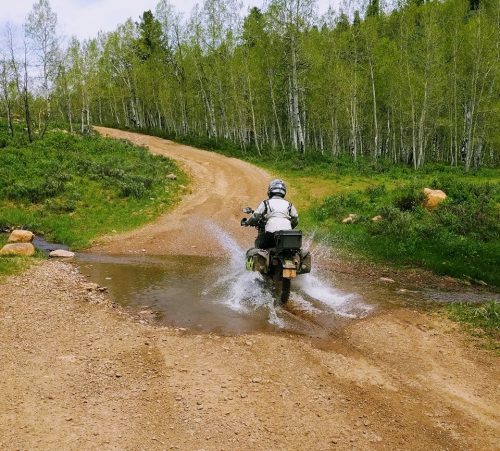
Going too slow
When learning to ride, I developed a skill that my hubby and I called “dirt bike hiking.” I used a lot of energy walking through the forest with a dirt bike between my legs. I knew, intellectually, that a two-wheeled vehicle needs to go a certain speed to stay balanced. I understood that, when riding off road, the terrain would slow me down; but there was a serious disconnect between this logic and my throttle hand. So I would go too slow, take my feet off the pegs, and pretty much walk through the ride until I was exhausted and need to rest.
Solution: So often, this was a result of looking at my front tire. As I learned to raise my head and eyes and look further down the trail, I learned my bike would roll over most things, and I learned to trust that I could open the throttle enough to stay at the balance point.
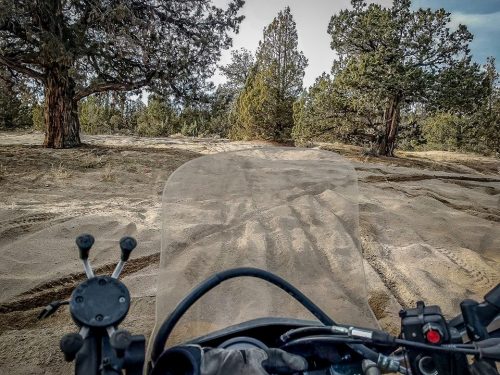
Whiskey Throttle & Butt Steer
Some of the best advice I read early on was to stand when riding my motorcycle off – road. Unfortunately, there was yet another disconnect between reading that and actually being able to do it. If you are sitting on your dirt bike and you roll over a rock, it sends a message up through your front wheel, your handlebars, and into your arms. Your hand rolls on the throttle, and this entire motion reverberates through your body. When your butt is on the seat, it communicates this disruption in balance through your behind and into the frame of the motorcycle, sending you out of control, and sometimes even causing a feedback loop back through your body and into your throttle hand. This becomes what we call whiskey throttle and butt steer, and is a really quick way to end up on the ground.
Solution: Stand while riding off road. Stand all the time. The fewer parts of your body you have contacting the motorcycle, the more the bike can move around under you, and your momentum will carry you forward and correct the instability caused by terrain. My ideal riding position includes big foot pegs that I am standing on, knees slightly bent, hands on the handlebars, elbows slightly bent. In this position, I can absorb all the obstacles in the trail and easily transition from this relaxed position into attack position for bigger obstacles.
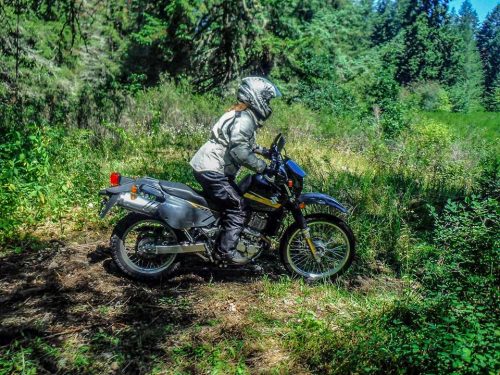
Stopping before an obstacle
I spent enough time early in my dirt biking days not hitting obstacles with enough speed and falling over. I would stop just before hitting a slippery root on the trail, get my front tire over it, and then spend the next 10 minutes sawing my back tire back and forth, back and forth, unable to get over it with no momentum; or I’d see a big hill and hit the brakes, causing me to be going too slow to get up the hill. I’d then get even slower because of the rocks on the hill slowing my momentum, and most of the time, fall over.
Solution: When you see something challenging, either stop way before it and evaluate the strategy you need to actually surmount the obstacle, or if you have gotten enough experience and your brain works quickly, assume the attack position, gather your momentum before the obstacle, look well past the obstacle you are conquering, and get through it successfully.
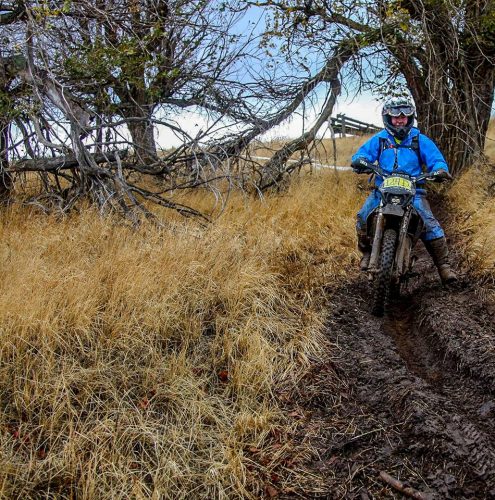
The Actual Art of Falling
For me, learning to do all of these things took a lot of time – five years and counting, so a word about falling: when you fall off of your motorcycle, remember that your bike (hopefully) has protective gear. Trying to save it will likely only hurt you, so try to get clear of the bike making sure it’s not falling on your legs. In an ideal fall, you drop your bike and walk off. But if you are falling with your bike, keep in mind that you are also (hopefully!) wearing protective gear. This will reduce the impact of falls, but your head is still delicate, and your hands are least protected. When you fall, it can be helpful to tuck your chin to keep your head from hitting the ground, and to tuck your arms and hands close to your body. Relaxing and rolling in the direction of the fall, allowing your momentum to wear off and protecting you from falling directly on your back can also be helpful. I’ve always been told that if you’re not falling – so if you fall a lot, take heart – you’re not learning. Falling means you are just improving your skills and becoming a better rider!
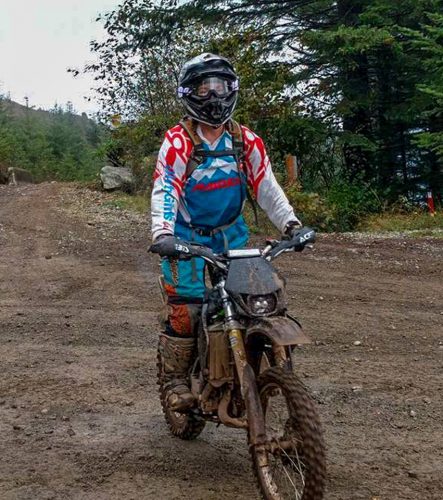

8 comments
A fine fine fine piece of good and witty writing! Laughed a lot (in recognition).
Great article, more please!
Such perfect timing to read this hilarious (hope you don’t mind me laughing) article. I just got my first off road bike home (and first bike after more than 15years). And I know all of what you wrote is about to apply to me!!
of course I don’t mind you laughing! It’s the first thing I do when I fall down; it echoes through the woods. 🙂 Have a wonderful time getting started again! We’ll look forward to hearing about your adventures!
Outstanding article! Very well written, and great information. Thank you. 🙂
Thanks Kris. I used to have a much bigger fear of falling because of once breaking my leg in two places in some sticky mud overseas. I took a class from an experienced off-road rider before my last adventure and it made a huge difference in my confidence. The best suggestion was looking ahead instead of down. I will now practice what I’ve read here and leave more fear in the dust.
So cool! Thanks for sharing Molly! We are going to be publishing more training articles soon. Riding after a big injury has been a challenge for me; it seems to turn on all the instincts that are opposite of what the bike needs me to do! Practice and training are definitely my friends!
Although I had ridden gravel roads as a youngster, when I attempted trail riding, I failed miserably. Much later, in my 60’s I happened to encounter a training program that enlightened me to the fact that there were SKILLS to be learned. Reading your article was a delight! So true your words!